
Hi Gang…
I’m honored to present another car that participated at Amelia Island Concours d’Elegance in March 2010 – Guy Dirkin’s Byers SR-100. Guy was kind enough to summarize his work and experience with the car. Let’s tell the story in his own words:
From the Desk of Guy Dirkin:
I acquired my Byers in August 2001. The car was built by two enthusiasts in the Madison ,Wisconsin area circa 1957-1958. The builders of the car followed the brief instructions provided by Jim Byers in his literature very closely as evidenced by the parts used. In 1959 the Byers was acquired by a gentleman in Kenosha, Wisconsin. He finished the car, painting it metallic maroon with gold fogging. He owned the car for over forty years, but during those four decades referred to the car as a Devin-Cobra special. He never knew it was a Byers.
The body was mounted on a 1949 Ford sedan chassis. 1949 was the first year Ford offered independent front suspension. The front and rear suspension was 1949 Ford with drum brakes all round. The 1949 Ford chassis was cut in the center and shortened to fit a 100 inch wheel base. The rear suspension was also 1949 Ford with stock 4:11 gears. The car had leaf springs. The floor of the car was plywood.
The engine in the Byers is a 1956 small block Chevrolet, located in a front mid engine position: You can stand between the front suspension cross member and the front of the engine in the engine bay! The 1956 Chevrolet V8 was the second production year of the small block Chevrolet engine and the first year the small block had an oil filter boss on the block. The displacement is 265 cu. in. The 1956 SBC has no castings for engine mounts on the side of the block, consequently the engine is mounted from the front of the block. For Chevy trivia buffs, 1956 engines were painted red, not orange.
When I purchased the car, the body and paint were in excellent condition, considering it had been on the car for over 40 years. I rebuilt the front suspension and improved the rear springs. I intended to use the car as a fun summer car. The car handled quite well, except that the rear leaf springs would move sideways causing rear steering.
Around 2004 the car was scratched by a vandal who maliciously keyed several major areas of the car. I was unable to repair the paint in a way that would leave an acceptable finish.
In retrospect, the vandal opened up options that would ultimately lead to the rebuilding of the car, meeting great people and ultimately an award at the Amelia Island Concour. So I suppose I should raise my glass to the vandal and wish him well. (PS I hope the vandal finds more productive outlets for his frustration following years of living without any balls!)
The original plan was to both restore the car and ready the car for vintage racing and track days. Below is a summary of the project.
- The 1949 front suspension was retained
- The front suspension has modified front uprights which lower the car 2.5 inches. These should be acceptable to pre-1957 Vintage organizations as they were hand made and could have been made in the 1950’s.
- The car can use both drum brakes and disc brakes on the same stub axle.
- From about 18 inches behind the front suspension, the chassis is new.
- The chassis allows for a longer foot box
- The chassis has a wider seating area.
- The chassis is much safer and more rigid
- The chassis has side impact protection
- The chassis now has a four link rear suspension with a panhard bar and coil over shock absorbers
- The tubing of the chassis was covered with sheet aluminum
- The side impact tubes will not be visible
- I removed and saved the original 1949 Ford axle, and installed a 1973 Ford 8 inch rear axle with a 3.25 ring and pinion and limited slip, as you cannot get many options in gear sets for the 1949 Ford.
- The Chassis has a fuel cell with rear impact protection
- The passenger(s) is protected by two bolt-in roll bars, both with a front bracing tube. One is asymmetric and the other is symmetrical: depending on if the car is raced or rallied. For car shows, these bars are removed.
- The transmission is a Muncie M21 close ratio, similar to a mid-1950’s Corvette
- The engine, at the moment, is still the 265 V8. It is probably 220 hp and 270 ft lbs. torque, which is close to stock.
- The clutch and flywheel are street specifications.
- The exhaust is two side exhausts with 3 inch pipes, with 24 inches of spiral baffles.
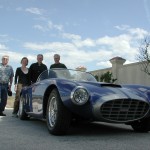
L to R: Mike Wittman, Carole Jackson, Guy Dirkin, and Rick D’Louhy at Amelia Island with Guy Dirkin’s Byers SR-100
The Byers ended up having an almost perfect 50/50 front rear weight distribution as well as side to side and diagonally, as you can see in the diagram. These weight distribution figures were achieved without weight-jacking.
Ironically, once the car was finished, the vintage race plans were tabled. The car is beautiful and I am reluctant to drop a race motor in the car and have it on the track. (My decision was helped by the recent purchase of an IMSA GT1 car). However, it would take minimal work to set the car up for vintage racing.
Guy finished his Byers in the summer of 2008, and debuted his car at the Barrington Concours d’Elegance held at the Arlington Heights Race Track in the north Chicago suburbs. With a bit of arm twisting, Guy and his friend Steve Steers (and Mike and Dawn Fisher too – Dawn owns the Glasspar G2 that was there), all came down from up north to join us with their cars at Amelia this past year.
We appreciate each of the folks who participated at Amelia and salute Guy for a beautiful restoration of his Byers SR-100 sports car.
Great story Guy, and thanks for sharing!
Geoff
Technical Specifications |
|
| Body |
|
| Designer |
|
| Body Work and Paint |
|
| Upholstery |
|
| Frame |
|
| Suspension |
|
| Engine (make/year) |
|
| Carburetion |
|
| Displacement |
|
| Horsepower (estimated) |
|
| Transmission (type/year) |
|
| Rear Axle / driveshaft (open/closed driveshaft) |
|
| Wheelbase |
|
| Track/Tread (front/rear) (distance between center line of tires) |
|
| Tire Size |
|
| Curb Weight |
|
| Top Speed (0-60) |
|
| Special Features |
|
- Byers as Found – It Needed More Work Than First Appeared
- First of Two Weight Balancing Analyses – Determining Chassis Design
- Guy and His Chassis – Restored and Ready for Newly Painted Body
- Guy’s Car Emerges from Restoration – Ready to Roll!!!
- L to R: Mike Wittman, Carole Jackson, Guy Dirkin, and Rick D’Louhy at Amelia Island with Guy Dirkin’s Byers SR-100

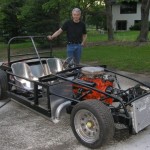

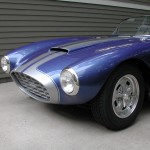
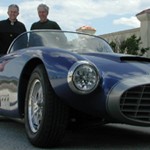

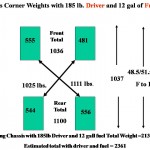
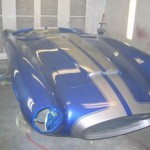





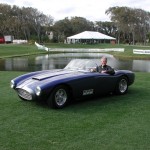
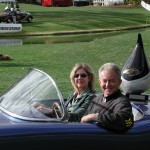
This site is protected by reCAPTCHA and the Google Privacy Policy and Terms of Service apply.